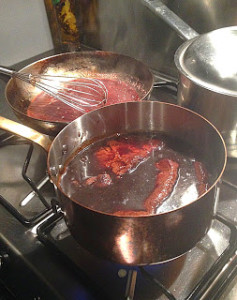Cooking
Recipes: Chinese master stock
Well over a decade ago, gluttonous husband decided to unlock the mysteries of Chinese cooking. Luckily for him, a very fine Chinese cooking school has been running in Melbourne for, well, decades.
Any Australian with a desire to learn about Chinese food has wended their way to Elizabeth Chong’s cookery school in Melbourne. Chong, who emigrated to Australia at the age of three, has demystified Chinese techniques and ingredients for generations of students – probably more than she’d care to admit to.
It was, arguably, one of the best investments of time and money gluttonous husband has made. In a wonderfully efficient series of three sessions, each lasting around an hour-and-a-half, he came away with a folder of recipes, a head full of ideas and began one amazing addition to our household’s pantry that has been used for a number of different dishes ever since – a Chinese master stock.
Master stock is something Chinese families are known to have kept going for generations. Our family’s brew is about 12 years old (and counting) so a relative pup by comparison. Gluttonous husband loves to use it specifically for two dishes – a black satin chicken and to gently poach pieces of fillet steak.
The master stock starts off by combining light and dark soy, water, slab sugar (found in Asian supermarkets), sesame oil, star anise and shitake mushrooms. The full recipe can be found below.
As the years go by and the stock is brought out of the fridge (it’s best if stored in a glass bottle) it requires topping up with various elements of the base stock, according to taste. Recently, gluttonous husband steeped another clove of star anise and added a little extra slab sugar, feeling those were the flavours that needed to come through. Because of the significant salt content of the stock, it just keeps on keeping on.
A favourite winter dish to present to friends is fillet steak poached in the stock, served with ‘Paris’ mashed potatoes, red onion jam and a red wine jus (pictured above). This is a variation on a dish first had at a restaurant at the Hungerford Hill winery in the Hunter region of New South Wales. The restaurant is no more, sadly, but blissfully committed the recipe to a newsletter before its untimely demise.
The differences between this version and the original include the substitution of red onion jam for a chilli jam and a red wine sauce for a veal jus.
So there’s four separate elements to prepare. This recipe is suitable for four portions but you’ll have a lot of leftover onion jam (a suggestion to use the remainder is included below!) and, of course, you can reuse the master stock again, and again and …
INGREDIENTS
2 cups light soy
2 tablespoons dark soy
Half cup water
1.5 pieces slab sugar (or you can substitute half a cup of rock sugar)
2 teaspoons sesame oil
2 cloves star anise
2 dried shitake mushrooms
METHOD
Soak the dried shitake mushrooms in warm water for about 30 minutes, then give them another rinse, make sure they’re well drained and remove any stems. Place them in a saucepan with all the other ingredients. Bring it to a boil then reduce heat and simmer (with a lid on) until the sugar is dissolved. Sieve out the star anise and mushrooms and the stock can be stored until you’re ready to use it.
INGREDIENTS
750 grams red onions, thinly sliced
30 grams unsalted butter
1.5 tablespoons soft brown sugar
1.5 tablespoons balsamic vinegar
1 teaspoon chopped thyme
METHOD
Melt the butter in a frying pan (you’ll need a large one to hold all the onions), add the sliced onion and cook over a low heat for around 40 minutes (they should be soft and golden). Add the sugar, vinegar and thyme, season with salt and pepper and cook for another 10 minutes. This mix can stay in an airtight container in the fridge until you need to use it – make sure you warm it up before you garnish the steak with it. It’s also delicious heaped into a pastry case and topped with a little goat’s curd and a sprig of fresh thyme.
360 grams desiree potatoes (or your favourite variety for mash), steamed and put through a strainer. Add 60 grams of butter and season with salt and tabasco – for four people you’d probably need around 1 teaspoon of tabasco for a lovely little hit of warmth.
Your sauce will only be as good as the red wine you use to make it! The rule of thumb is don’t use in cooking what you wouldn’t be prepared to drink out of a glass. In an ovenproof saucepan, roast half a stick of celery, half a carrot and half a brown onion with a small amount of olive oil, until it colours – in the oven at 180 degrees for half an hour should do it. Put on stove top, add about a cup of red wine (more if you have some over, just reduce it down more). It needs to reduce to almost just a sticky residue without burning. Add a cup of beef stock and reduce again until you have around 100 ml left in the pan. Strain it, return to the pan, reduce slightly again. Just before serving, drop a couple of pieces of cold butter in and whisk for a glossy finish.

Poach the steak in a gently simmering master stock
Make sure your steak is at room temperature before you put it into the gently simmering master stock. A fillet steak around 130 grams will need to poach for about eight minutes to be medium rare. If you have a bigger fillet, slice it horizontally for two medallions. You don’t need to season the steak – there’s more than enough salt in the stock. Then all you have to do is plate up. A pile of mash, topped with the steak, topped with the warmed red onion jam and a lovely slurp of the jus over the top.
Once cooking is complete, allow the master stock to cool and strain it back into your container (glass is best), seal and keep in the fridge, ready for next time – however many days, months or even years later.
Post Views: 5,140






Comments